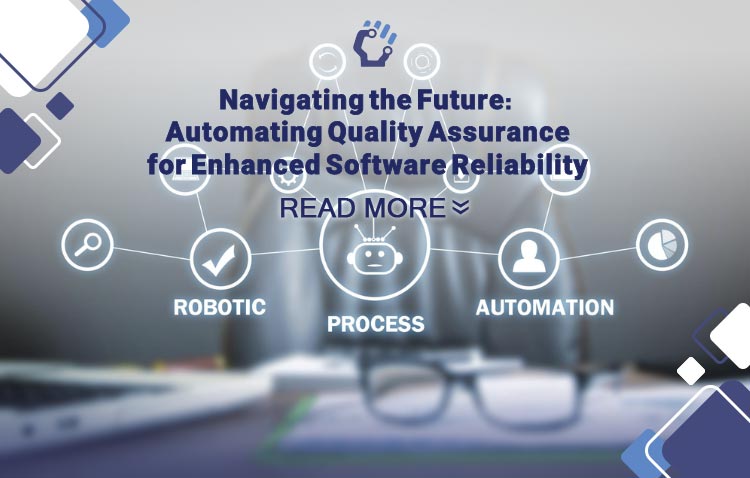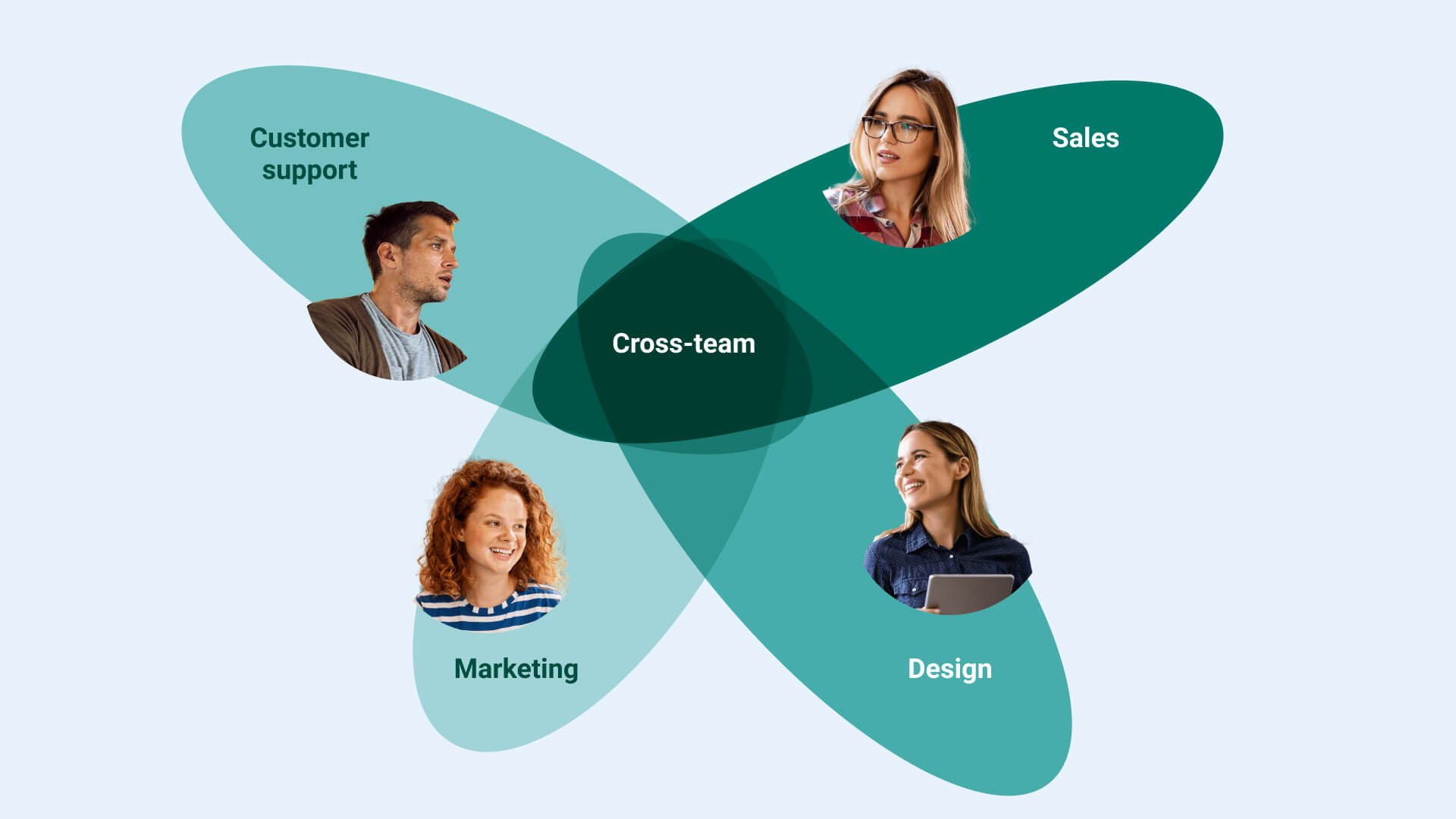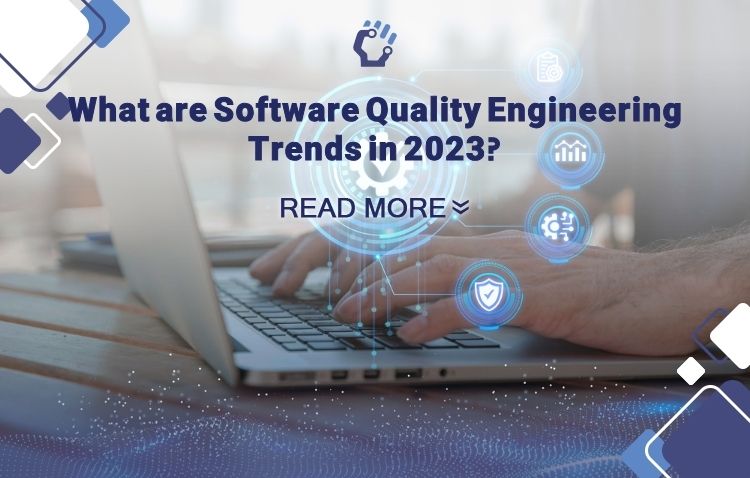In the ever-evolving landscape of software development, the compass points towards a future where reliability is not just an aspiration but an intrinsic characteristic. Welcome to the era of Automated Quality Assurance (QA), where the very fabric of software testing is woven with precision and innovation. As we embark on this journey of technological evolution, the keyword that resonates is not just automation; it's the artful orchestration of "Automated QA."
Picture a horizon where software reliability is not a destination but a dynamic landscape shaped by the seamless integration of cutting-edge technology and strategic quality assurance practices. In this exploration of the future, we delve into how Automated QA is the compass guiding us through the complexities, ensuring that every line of code is a testament to enhanced software reliability. Fasten your seatbelts as we navigate through the realms of innovation, efficiency, and adaptability, ushering in an era where Automated QA is not just a tool but the cornerstone of unparalleled software reliability.
The Evolution of Quality Assurance: Embracing the Power of Automation
In the dynamic realm of software development, the story of Quality Assurance (QA) is one of continuous evolution. As we stand at the crossroads of tradition and innovation, the narrative unfolds into a new chapter—one where the steadfast embrace of automation becomes the catalyst for transformative change.
In the not-so-distant past, QA was synonymous with manual efforts, a meticulous yet time-consuming endeavor. The advent of complex applications and the demand for quicker release cycles has sparked a paradigm shift. Enter automation—an evolutionary leap that promises not just efficiency gains but a fundamental alteration in how we safeguard the reliability of our software.
This section delves into the narrative of the "Evolution of Quality Assurance: Embracing Automation." It's a journey that explores how automation isn't merely a tool; it's a philosophy that redefines the very essence of QA. Fasten your seatbelts as we navigate through the historical landscape, witness the challenges faced, and illuminate the path forward—a path where automation and QA converge to usher in an era of enhanced software reliability.
Strategic Implementation: Key Components of Automated QA
Unpacking the realm of Automated Quality Assurance involves a nuanced exploration of its core components. Each facet contributes to the intricate tapestry that fortifies software reliability, ensuring a robust foundation for the entire development lifecycle.
Meticulous Test Scripting: Crafting Precision in QA
At the heart of Automated QA lies the art of meticulous test scripting. These scripts are not mere lines of code; they are the architects of a comprehensive examination. By defining the steps and expected outcomes, test scripts guide the software through a journey of validation, enhancing the precision and coverage of the testing process.
Seamless Integration with Development Pipelines: The Dance of Cohesion
In the ever-evolving landscape of software development, cohesion is paramount. The seamless integration of automated QA into development pipelines transforms the testing process into a synchronized dance. This integration ensures that every code change triggers automated tests, fostering early detection of issues and maintaining the integrity of the entire software ecosystem.
Data-Driven Testing: Leveraging Information for Reliability
Data is not just a byproduct; it's a strategic asset in Automated QA. The practice of data-driven testing involves using a diverse set of inputs to validate different scenarios. By leveraging real-world data, this approach enhances the reliability of testing, ensuring that the software performs effectively under various conditions.
Continuous Monitoring: Vigilance Beyond Deployment
The journey of quality assurance doesn't conclude with deployment. Continuous monitoring is a strategic component that extends the watchful eyes of QA into the post-deployment phase. By actively observing the software in real-world scenarios, this practice allows for the early identification of potential issues and ensures sustained reliability.
Adaptable Test Environments: Navigating Change with Grace
In the dynamic landscape of software development, change is inevitable. The strategic implementation of Automated QA involves creating adaptable test environments. These environments can gracefully accommodate changes in the application's structure or functionality, ensuring that automated tests remain relevant and effective in the face of evolution.
As we navigate through the strategic components of Automated QA, the overarching theme is one of precision, integration, and adaptability. It's not merely about automating processes; it's about strategically orchestrating a symphony where each component plays a crucial role in fortifying software reliability. In the grand scheme of software development, this strategic implementation becomes the backbone, ensuring that "Automating Quality Assurance" is not just a task but a strategic imperative for delivering reliable and resilient software.
Efficiency Unleashed: The Impact of Automated Testing
Automation testing isn't merely a race for speed; it's a journey towards unparalleled efficiency. In this segment, we delve into the profound impact of automated testing—a transformative force that goes beyond velocity, becoming the catalyst for enhanced software reliability. Picture it not as a sprint but as a meticulously choreographed dance, ensuring a swift yet thorough examination of every line of code.
Precision at Scale: Automated Testing's Artful Dance
In the realm of automated testing, precision is not sacrificed for speed; rather, they dance together in harmony. Automated tests execute with meticulous accuracy, covering vast swaths of functionality in a fraction of the time it would take through manual testing. This precision ensures that every interaction, every function, is scrutinized with the same unwavering attention, fostering reliability in every corner of the software.
Regression Testing: Safeguarding Against the Domino Effect
Software development is iterative, with changes introduced to enhance features or fix issues. Here, automated testing shines as a guardian through regression testing. It systematically validates that new code changes haven't inadvertently disrupted existing functionalities. By preventing the domino effect of unintended consequences, automated testing becomes a stalwart protector of software reliability.
Comprehensive Test Coverage: Ensuring No Stone Goes Unturned
Automated testing doesn't merely skim the surface; it dives deep into the labyrinth of code. Its impact is felt in the breadth of test coverage, ensuring that no stone goes unturned. Whether it's functional, non-functional, or integration testing, automated tests provide a comprehensive safety net, assuring that the software stands resilient against a spectrum of potential issues.
Early Detection, Swift Correction: Nipping Issues in the Bud
The efficiency of automated testing lies not just in speed but in the agility to detect issues early. By integrating seamlessly into the development pipeline, automated tests become the vigilant scouts, spotting anomalies in real time. This early detection allows for swift correction, minimizing the impact of issues and contributing to the overall reliability of the software.
Consistent Execution: Reliability by Design
Automation brings a rhythm of consistency to testing, executing predefined scenarios with the precision of a well-rehearsed performance. This consistency is more than a convenience; it's a reliability enhancer. Automated tests, when executed consistently, deliver dependable results, instilling confidence in the software's performance across various scenarios.
In essence, the impact of automated testing extends far beyond the notion of speed. It's a meticulous dance of precision, a vigilant guardian against unintended consequences, and a comprehensive safety net that ensures no aspect of software reliability is left to chance. As we explore the efficiencies unleashed by automated testing, we unveil a narrative where each line of code is not just examined; it's embraced with the assurance of reliability—a testament to the transformative power of automation in the realm of software quality assurance.
The Dance of CI/CD: Where Automated QA Meets Development Workflow
In the intricate tapestry of modern software development, Continuous Integration and Continuous Deployment (CI/CD) emerge as the rhythmic heartbeat. This section is a journey into the symbiotic relationship between automated QA and CI/CD—a seamless dance that propels software reliability to new heights. Picture it not as a mechanical process but as a graceful waltz, where each step contributes to the harmony of the entire development workflow.
Harmony in Integration: CI as the Prelude
Continuous Integration serves as the opening note in this musical composition. It's the practice of regularly integrating code changes into a shared repository. Think of it as the choreography that ensures the dance remains synchronized. With automated QA intricately woven into CI, every integration becomes an opportunity for automated tests to perform their elegant routine, checking the harmony of the code ensemble.
The Choreography of Deployment: CD as the Grand Finale
Continuous Deployment takes the lead in the grand finale. It orchestrates the deployment of successfully tested code changes to production—a culmination of the development symphony. The seamless transition from CI to CD mirrors a flawless dance routine, where each movement is deliberate, and every step is taken with the confidence derived from automated quality assurance.
Feedback Loop: The Elegance of Iteration
Imagine this dance as an ongoing performance, never static but continually evolving. The synergy between automated QA and CI/CD creates an elegant feedback loop. Automated tests provide feedback on each integration, allowing developers to refine their steps in real-time. This iterative process ensures that software reliability is not a final act but an ongoing refinement, akin to the evolution of a beautifully choreographed dance.
Swift Corrections: Addressing Missteps in Real-time
In this dance, missteps are inevitable, but the beauty lies in swift corrections. Automated QA integrated into CI/CD ensures that issues detected during testing are swiftly addressed. Picture it as a quick twirl to realign with the rhythm, ensuring that the software dance remains on beat and in tune with user expectations.
Parallel Performances: Multifaceted QA in CI/CD
The beauty of this dance lies in its multifaceted nature. While CI focuses on integrating code changes, CD orchestrates deployment, and automated QA performs a parallel routine. Each aspect complements the other, contributing to the multifaceted performance that ensures the reliability of the entire software production.
Culmination in Reliability: The Standing Ovation
As the dance reaches its crescendo, the culmination is not just in deployment but in reliability. The audience, in this case, is the end-users, and their applause is reflected in the seamless and reliable software experience. The standing ovation is not just for the final act but for the entire choreography, showcasing the brilliance of automated QA in perfect harmony with the dance of CI/CD.
In essence, the dance of CI/CD and automated QA is a mesmerizing performance where each component contributes to the overall reliability of software. It's not just a mechanical process; it's a choreographed masterpiece, showcasing the synergy between automation and the rhythm of development workflows. As we witness this dance unfold, we find ourselves in a narrative where software reliability is not a mere result but the artistic expression of a harmonious collaboration between automated QA and the dance of CI/CD.
Adapting to Change: Navigating Dynamic Challenges in Automated QA
In the dynamic symphony of software development, change is not merely an occasional note; it's a constant melody. This section is a voyage into the realm where automated QA, like a seasoned maestro, orchestrates its techniques to adapt to the ever-evolving environments. Imagine it not as a rigid performance but as an improvisational jazz piece, where the harmonious adaptability of automated QA ensures that software reliability remains unwavering amid the shifting landscapes.
The Agility of Automated Test Scripts: A Dance of Flexibility
In the face of evolving environments, automated test scripts become agile dancers, gracefully adapting their steps to the changing rhythm. These scripts are not etched in stone but are designed with flexibility in mind. They adjust seamlessly to modifications in the application's structure or functionality, ensuring that the testing dance remains relevant and effective in the midst of change.
Version Control: A Conductor’s Baton in QA Symphony
Change in software development often brings the need for version control—a conductor's baton that orchestrates the harmony of different elements. Automated QA techniques embrace version control, allowing for the synchronization of changes across the testing suite. This ensures that every member of the orchestra, from test scripts to test data, is in tune with the latest developments.
Environment Configuration Management: Setting the Stage Right
Envision the software environment as a stage, and automated QA as the stage manager ensuring everything is set right. Dynamic challenges demand nimble adaptations, and that's where environment configuration management shines. It ensures that the testing stage is accurately configured, whether for development, testing, or deployment, adapting to the changing requirements of the performance.
Shift-Left Testing: Anticipating Change Before It Happens
In the dynamic world of software, anticipation is key. Shift-Left Testing is the foresighted dancer, moving ahead of the beat to anticipate changes before they happen. By integrating automated QA into the early stages of development, this technique ensures that potential issues are identified and addressed proactively, contributing to the overall reliability of the software.
Collaborative QA: A Ensemble of Expertise
In the face of change, the collaborative nature of automated QA comes to the forefront. It's not a solo performance but an ensemble of expertise. Testers, developers, and stakeholders collaborate to adapt to evolving requirements. The diverse perspectives within this ensemble enhance the ability to navigate change, ensuring that software reliability is a collective achievement.
Continuous Learning: The Growth Mindset of QA
In the dynamic landscape, learning is not a one-time event; it's a continual process. Automated QA embodies a growth mindset, where every challenge is an opportunity to learn and improve. Techniques evolve, tools are refined, and the dance of adaptation continues, ensuring that the QA performance is always at its peak.
As we navigate the dynamic challenges in automated QA, the underlying theme is one of adaptability. It's not about resisting change but about dancing with it, ensuring that the reliability of the software performance endures amid the dynamic shifts. In this narrative, automated QA isn't just a reactive force; it's a proactive partner, anticipating and adapting to change—a testament to the resilience that ensures software reliability remains unwavering in the face of evolving environments.
Read more: QA Challenges Across Companies and Roles
Beyond Functionality: Navigating Non-Functional Realms in Automated QA
In the vast landscape of software reliability, there's a realm that transcends mere functionality—a realm where performance, security, and usability take center stage. This segment is an exploration into the non-functional dimensions of Automated QA, envisioning it not just as a spotlight but as a comprehensive illumination of the software's holistic health. Picture it not as a narrow focus but as a panoramic view, where non-functional testing in automated QA reveals the intricacies that contribute to the software's reliability.
Performance Testing: The Pinnacle of Endurance
In the realm beyond functionality, performance testing stands as the pinnacle of endurance. Automated QA becomes the athlete, rigorously assessing how the software performs under varying conditions—be it heavy user loads or fluctuating network speeds. The goal is not just to ensure functionality but to guarantee a smooth and efficient user experience even when the software is pushed to its limits.
Security Testing: Safeguarding the Fort
In this holistic approach, security testing is the vigilant guardian of the software fortress. Automated QA dons the armor, probing for vulnerabilities and weaknesses in the software's defenses. It's not just about functionalities being in place; it's about ensuring that sensitive data remains impervious to potential threats, creating a reliable shield against the ever-present risks in the digital landscape.
Usability Testing: The User-Centric Dance
Beyond functionalities lies the user-centric dance of usability testing. Automated QA becomes the choreographer, orchestrating tests to ensure that the software not only works but works intuitively and seamlessly for end-users. This aspect of non-functional testing ensures that reliability isn't just a technical achievement but a user-centric experience that fosters satisfaction and loyalty.
Scalability and Reliability: The Symbiotic Duo
In the non-functional realm, scalability is the partner to reliability. Automated QA assesses how well the software scales to meet growing demands. This duo ensures that the software not only functions reliably in its current state but can adapt and thrive as user numbers and data volumes increase—making scalability an inherent part of its reliable performance.
Compliance Testing: Navigating Regulatory Waters
Software reliability extends into the waters of compliance. Automated QA becomes the navigator, ensuring that the software adheres to regulatory standards and industry requirements. This holistic approach safeguards against legal pitfalls, ensuring that the software not only functions reliably but does so within the boundaries of legal and ethical frameworks.
Accessibility Testing: Ensuring Inclusivity
In the broad spectrum of software reliability, inclusivity takes the stage in accessibility testing. Automated QA becomes the advocate, ensuring that the software is accessible to users of all abilities. This commitment to inclusivity is not just a regulatory checkbox but a testament to the reliability of the software's reach and impact.
As we venture beyond functionality into the non-functional realms of automated QA, the narrative expands from checking boxes to creating a comprehensive user experience. It's not just about what the software does; it's about how well it performs, how securely it guards data, and how intuitively it interacts with users. In this holistic journey, automated QA becomes not just a tester of functionalities but a curator of the entire software experience, showcasing the reliability that extends far beyond the codebase.
Data-Driven Assurance: Unleashing the Power of Information in QA
In the orchestra of Quality Assurance, data isn't a mere byproduct—it's the virtuoso, a valuable asset that enhances the symphony of testing. This segment is a journey into the realm of data-driven testing, envisioning it not just as a technique but as a powerful conductor orchestrating the reliability of software. Imagine it not as a spreadsheet but as a sonnet, where data-driven assurance transforms information into a melody that validates various scenarios under diverse conditions.
Data as the Maestro: Guiding the QA Symphony
In the realm of data-driven assurance, data assumes the role of the maestro, directing the QA symphony with finesse. It's not about inundating tests with random data; it's about crafting a narrative that explores the boundaries and nuances of the software's functionality. Each piece of data is a note in this composition, contributing to the reliability of the overall performance.
Scenario Validation: Crafting Real-World Narratives
Data-driven testing transcends the rigidity of predefined scenarios. It's about crafting real-world narratives by leveraging diverse sets of data. Automated QA becomes the storyteller, validating the software's reliability under various conditions, mimicking the dynamic nature of user interactions. This approach ensures that the software isn't just reliable in controlled environments but in the unpredictable landscapes of the real world.
Dynamic Test Coverage: Tailoring Assurance to Every Contour
The beauty of data-driven assurance lies in its ability to dynamically adapt to different contours of the software. It tailors test coverage based on the richness of data, ensuring that the reliability assessment encompasses a broad spectrum of scenarios. It's not just about quantity but the qualitative impact of data on the depth and breadth of testing.
Parameterized Tests: The Custom-Tailored Approach
Imagine parameterized tests as bespoke suits—custom-tailored to fit the unique dimensions of the software's functionality. Data-driven assurance allows for parameterized tests, where inputs are not static but are variables derived from the data. This dynamic approach enhances the reliability of testing, accommodating variations in user inputs and system interactions.
Edge Case Exploration: Unveiling the Unseen
In the quest for reliability, data-driven assurance delves into the uncharted territories of edge cases. It's the explorer uncovering scenarios that might be rare but are crucial for ensuring robust software performance. The emphasis is not just on routine testing but on unveiling the unseen, fortifying the software against potential pitfalls.
Adaptability to Change: A Living Assurance Ecosystem
In the dynamic landscape of software development, change is inevitable. Data-driven assurance, like a living ecosystem, adapts seamlessly to these changes. Whether it's modifications in the software's functionalities or the addition of new features, the reliance on data ensures that testing evolves in sync with the software, contributing to its ongoing reliability.
As we unravel the concept of data-driven assurance, the narrative expands from static tests to dynamic validations. It's not just about running tests; it's about orchestrating a symphony where data is the conductor, directing the assurance efforts towards a comprehensive and reliable software experience. In this journey, data-driven assurance becomes more than a technique; it's a narrative sculptor, shaping the story of software reliability through the rich tapestry of information.
Challenges and Solutions: Navigating the Complexities of Automated QA
Every journey, no matter how exhilarating, comes with its share of challenges. In the symphony of automated Quality Assurance, these challenges are the notes that require careful orchestration. This section is a candid exploration of the nuances and intricacies—providing insights into the obstacles faced and the solutions devised in the relentless pursuit of enhancing software reliability through automated quality assurance. Think of it not as a roadblock but as a series of dance steps that demand finesse and adaptability.
Test Maintenance Overhead: The Choreography of Code Changes
In the dynamic realm of software development, code changes are the dancers that gracefully move across the stage. However, with each change, there's a potential ripple effect on automated tests. The challenge lies in the maintenance overhead—ensuring that tests remain relevant and effective. The solution involves a proactive choreography, where automated tests are designed with modularity and flexibility, allowing them to adapt to code changes without causing a disruption in the overall performance.
Flaky Tests: The Unpredictable Dance Partners
Flakiness in tests is akin to unpredictable dance partners, making the performance inconsistent. The challenge is in dealing with environmental factors or system dependencies that lead to test instability. The solution involves meticulous scripting, error handling mechanisms, and rerun strategies. It's about transforming the dance into a resilient routine, where even unpredictable partners can be gracefully accommodated.
Data Management Complexities: Orchestrating the Information Ensemble
In the data-driven symphony of automated QA, managing the ensemble of information can become complex. The challenge lies in orchestrating diverse sets of data while ensuring data integrity and security. The solution involves a data management strategy that includes robust data generation, masking sensitive information, and maintaining a balance between data richness and simplicity. It's about orchestrating a harmonious data ensemble that enriches testing without overwhelming it.
Integration with CI/CD: The Rhythm of Continuous Harmony
While CI/CD brings harmony to the development workflow, integrating automated QA seamlessly can be a challenge. The solution involves creating a continuous dance where automated tests become an integral part of the CI/CD pipeline. It's about synchronizing the rhythm, ensuring that testing doesn't become a bottleneck but flows seamlessly, contributing to the overall harmony of software development.
Non-Functional Testing Complexity: The Multifaceted Ballet
Non-functional testing introduces complexity with its multifaceted nature, encompassing performance, security, usability, and more. The challenge is in orchestrating this ballet of testing types without losing sight of the holistic software reliability goal. The solution involves a well-structured testing strategy, dividing the dance into distinct acts and ensuring that each aspect contributes cohesively to the overall performance.
Balancing Test Coverage: The Delicate Dance Steps
The dance of test coverage requires a delicate balance. Too little, and critical scenarios may be missed; too much, and testing becomes overwhelming. The challenge is in finding the equilibrium. The solution involves a strategic approach to test design, focusing on high-impact scenarios while being mindful of not overburdening the dance with unnecessary steps. It's about crafting a dance routine that covers the essentials with grace and efficiency.
As we navigate the complexities of automated QA, challenges are not roadblocks but opportunities to refine the dance. Each obstacle addressed, each solution implemented, contributes to the maturation of the performance. In this narrative, challenges become the catalysts for innovation, and solutions emerge as the elegant dance moves that propel us toward the ultimate goal—enhancing software reliability through the artful orchestration of automated quality assurance.
The Future Horizon: Paving the Way for Uncharted Excellence in Automated QA
As we bid adieu to the present, let's embark on a journey into the future of Automated QA—a journey that involves peering into the proverbial crystal ball, attempting to discern the trends and innovations that will shape the landscape of software reliability. It's not just a conclusion; it's an invitation to speculate on what lies ahead and how these advancements will contribute to an unprecedented level of excellence in the ever-evolving tech landscape.
AI and Machine Learning: The Maestros of Adaptive Testing
Picture a future where AI and machine learning become the maestros of adaptive testing. These technologies will not merely follow scripted routines but dynamically adapt testing strategies based on evolving code changes and user behaviors. The orchestra of automated QA will become more intelligent, self-optimizing, and adept at predicting potential issues before they manifest.
Autonomous Testing: The Symphony of Self-Driving QA
Imagine a world where testing is not just automated but autonomous—a self-driving QA ecosystem. Test scenarios are identified, executed, and refined without explicit human intervention. This evolution will free up human testers to focus on more strategic aspects, while the automated system navigates the testing landscape with efficiency and precision.
Quantum Computing: Revolutionizing Complex Scenario Testing
As quantum computing inches closer to reality, its potential impact on automated QA is profound. Complex scenario testing that was once deemed impractical due to computational constraints will become routine. Quantum-powered automated QA will unravel new dimensions of testing, simulating intricate scenarios that were previously beyond the reach of classical computing.
Integrating DevOps and AIOps: The Unified Symphony of Development and Operations
The future of Automated QA will witness a seamless integration of DevOps and AIOps, creating a unified symphony where development, operations, and QA harmonize effortlessly. The convergence of these disciplines will result in a continuous and intelligent feedback loop, ensuring that software reliability is not just a post-development consideration but an integral part of the entire software lifecycle.
Ethical AI Testing: Ensuring Responsible Technology
As AI takes center stage, ethical considerations in testing become paramount. The future of Automated QA will see the emergence of ethical AI testing, ensuring that automated systems not only deliver reliable results but also adhere to ethical principles. This shift reflects a conscientious approach to technology, where software reliability is intrinsically linked to responsible and ethical use of automated testing.
Distributed Testing Networks: Navigating Global Software Ecosystems
With the increasing globalization of software development, the future will witness the rise of distributed testing networks. These networks will enable comprehensive testing across diverse geographic locations and ensure that software reliability is validated in real-world conditions, accommodating variations in infrastructure, network speeds, and user behaviors across the globe.
Human-Centric Testing: The Fusion of Human and Machine Intelligence
In the future horizon of Automated QA, human-centric testing will take precedence. This involves the fusion of human and machine intelligence, where human testers collaborate seamlessly with automated systems. This collaborative approach ensures that the nuanced aspects of user experience and subjective evaluations are incorporated into the testing process, enriching the reliability assessment.
Blockchain in Testing: Fortifying Security and Traceability
As blockchain technology matures, its application in testing will fortify security and traceability. The future of Automated QA will see the integration of blockchain for secure storage of test results, ensuring the integrity of testing data and providing an immutable record of the testing process. This enhances transparency, accountability, and reliability in the testing ecosystem.
As we gaze into the future of Automated QA, it becomes evident that the journey is not just about automating processes but about redefining the very nature of software reliability. The trends and innovations outlined are not just futuristic speculations; they are the building blocks of a future where automated quality assurance becomes synonymous with unmatched excellence. It's an exciting frontier, an uncharted territory that beckons us to push the boundaries of possibility, ensuring that the reliability of software continues to evolve with the ever-changing rhythms of technology.








